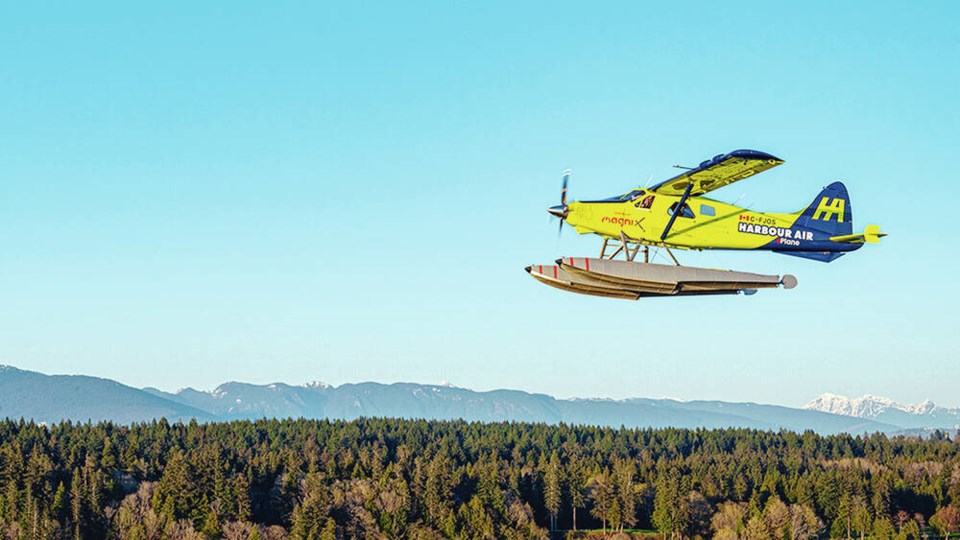Harbour Air’s electric Beaver aircraft that made a historic flight from Richmond to Sidney on Wednesday will be on show at today’s B.C. Aviation Museum open house.
Harbour Air senior vice-president Randy Wright said the e-Beaver will be on display from 10 a.m. to 4 p.m. Some of the electric aircraft’s engineers and maintenance staff will be on hand to answer questions about the unique seaplane.
“One of the reasons we made this flight over to Victoria and got Transport Canada permits to do so was to have it at the museum for their special event,” Wright said Friday. “It’s a star attraction and a pretty special plane.”
Harbour Air completed the first point-to-point test flight using its all-electric plane on Wednesday. The modified de Havilland Beaver, with tail number CFJOS, was tracked via FlightAware as flying from Richmond to Patricia Bay in North Saanich — a distance of 72 kilometres — in about 22 minutes.
Wright said the plane, with an electric engine powered by batteries, travelled at about 105 miles per hour — slightly faster than a typical Harbour Air passenger flight — and had ample reserve battery power when it landed. It flew at an altitude of about 500 feet, Wright said.
The company called it a “major milestone in the advancement of all-electric commercial flights.”
Laura Lavin, president of the B.C. Aviation Museum, said having the e-Beaver at the open house brings a major attraction to the non-profit museum, especially after two years of limited visits because of the pandemic.
“It’s so exciting to have this electric plane because we tend to focus on the past and the history of aviation,” she said. “But this is the future of aircraft and I think people will find that very interesting.”
Wright said the e-Beaver that made the crossing is the second version of the electric Beaver. Harbour Air and its partner, MagniX, an electric aircraft engine manufacturer based in Everett, Washington, have made several tweaks over the past year, including adding lighter, more powerful batteries by Swiss company H55.
H55 is a technological spinoff of Solar Impulse, which became the first electric plane to fly around the world. The 40,000 kilometre journey took 14 months and 550 hours in the air without a drop of fuel and using only the sun’s rays, finishing in July 2016.
“It’s all about the batteries and all about the weight,” said Wright.
Kory Paul, Harbour Air’s vice-president of flight operations and one of the company’s test pilots, said the e-Beaver’s hop over from the mainland went exactly as planned. He said Harbour Air, MagniX and Transport Canada closely monitored the aircraft’s performance and the flight and “further proved the safety and reliability of what we have built.”
Wright said the electric engines are quieter — about “half as loud as a traditional piston [engine].”
Harbour Air chief executive Greg McDougall initially flew the 750-horse-power, electric-powered float plane over the Fraser River in December 2019. The short test flight went in the aviation history books as the world’s first all-electric commercial aircraft flight.
Wright said Harbour Air hopes to achieve Transport Canada certifications to start carrying passengers by electric seaplane in early 2024 as parts for the engines and battery systems start making their way through clogged global supply chains.
The company said it is uniquely positioned to be the leader in commercial electric flight, citing the small sizes of its single-engine aircraft and its short routes, usually 30 minutes or less.
It plans to eventually electrify its entire fleet of de Havilland Beaver and Otter aircraft at a cost of about $4 million per plane. Those costs, however, could come down as supply chain issues improve, said Wright.
The aviation museum will have 30 of its own aircraft on display today, including a vintage Vickers Viscount commercial airliner showing what some of the first long-distance air travel was like in the 1950s and a 1956 Grumman S-2 Tracker, an anti-submarine aircraft which can fold its wings.
The 443 Squadron will also be on hand with one its new Cyclone helicopters and the Catalina Preservation Society will have historic aircraft for people to view.
The museum, at 1910 Norseman Rd., Sidney, also has an extensive display of aviation artwork and models as well as a library; local fire departments, museums and other organizations will have displays. Several kids’ activities are planned, along with military re-enactments, food trucks and draws for flights.
Entry to the open house is by donation, which helps the museum cover its operating costs.

